Click on any picture below for an uncropped image.
After a second night sleeping on the floor of Ko Dut DIC, we shared breakfast with the volunteers. We said our 'goodbyes' to our friends at Ko Dut and embarked on a little sightseeing.
We drove to Thanbyuzayat which I'd first visited in 2012 (blog post here, supposedly named after the ‘tin shelter’ in the town centre which looks like a Victorian bandstand.
During the Second World War the area achieved notoriety because of the construction of the 'Death Railway'. To support the large Japanese Army which occupied Burma, the Japanese forced Commonwealth, Dutch and American prisoners of war to construct a metre gauge railway line over 400 km long connecting Siam (now Thailand) with the existing railway line through Thanbyuzayat. Work commenced late in 1942 and Thanbyuzayat became a Base Camp and Prisoner of War administration headquarters. In January 1943, a Hospital was added. Heavy prisoner casualties were also sustained during Allied bombing raids on the railway infrastructure in March and June 1943, resulting in prisoners and the sick being marched to dispersal camps along the new railway. Owing to the dreadful conditions, over 13,000 prisoners of war died during the construction, together with up to 100,000 conscripted or forced labourers from Malaya, Dutch East Indies, Siam and Burma. The railway was completed in December 1943.
After the War, graves were transferred to War Cemeteries in Chungkai and Kanchanaburi in Thailand and Thanbyuzayat in Burma. The remains of American prisoners were repatriated to the United States. We spent a few minutes at the War Cemetery at Thanbyuzayat, which has 3,149 Commonwealth and 621 Dutch graves maintained by the Commonwealth War Graves Commission. Their web page for this cemetery is here.
 Thanbyuzayat War Cemetery.
Thanbyuzayat War Cemetery.
Just south of the town, there's a commemorative plaque and a short length of track displaying what is claimed to be the first Japanese steam locomotive to run on the 'Death Railway'. In 2012, waterlogged ground made close inspection impractical but in 2014 I was able to study the rather battered locomotive. I was intrigued that bronze fittings had been replaced by wooden replicas, painted yellow.
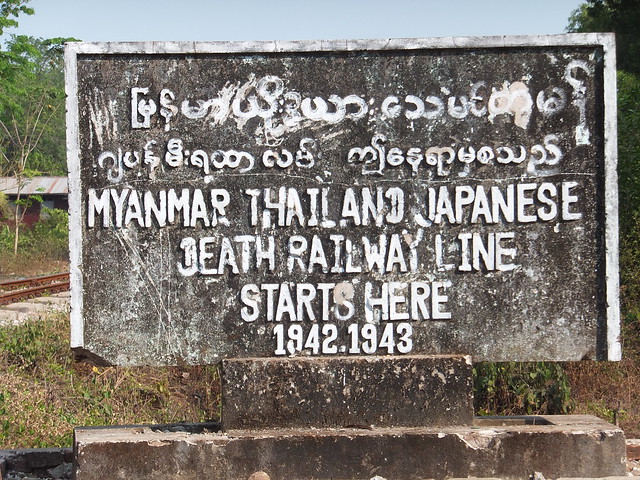 Plaque marking the end of the 'Death Railway'.
Plaque marking the end of the 'Death Railway'.
Next, we travelled west to Khaikhami Yele Paya temple built in the sea. On my earlier trip, construction of the concrete pier leading to the temples was being completed and the original wooden pier was still standing. By 2014 the old wooden pier had been removed. It was good to re-visit with the Doctor and his son.
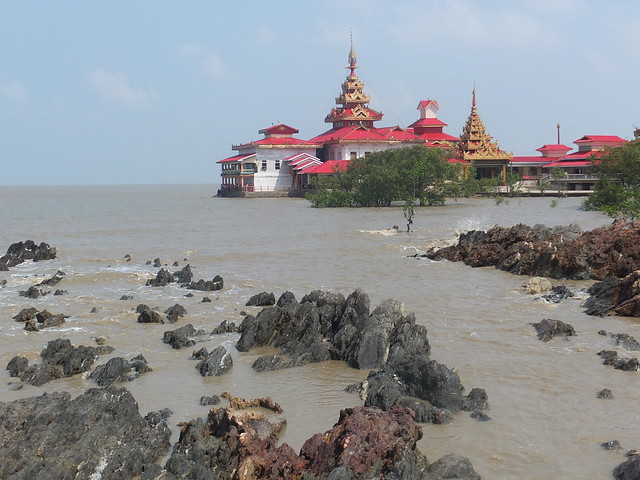 Khaikhami Yele Paya
Khaikhami Yele Paya
After visiting the temple, Doctor Hla Tun decided to purchase some fish to take back to Yangon. This involved some pretty serious discussion involving at least three of the stallholders and multiple weighings of the fish.
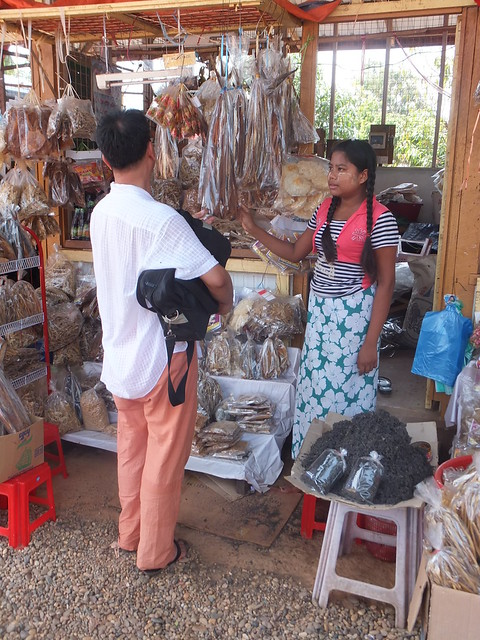
Purchasing fish.
Nearby, we visited an orphanage called 'Mirror Image' run by Sister Martha, a Catholic nun. Her English was excellent (she'd worked for 18 months in Moss Side, Manchester). Doctor Hla Tun donated medication. There were plaques crediting the assistance provided by the 'Grassroots Grant Assistance Scheme' in Japan and the Government of the Federal Republic of Germany. Three assistants were engaged in preparing monthly prescriptions of Anti Retroviral Treatment for issue to patients in their care.
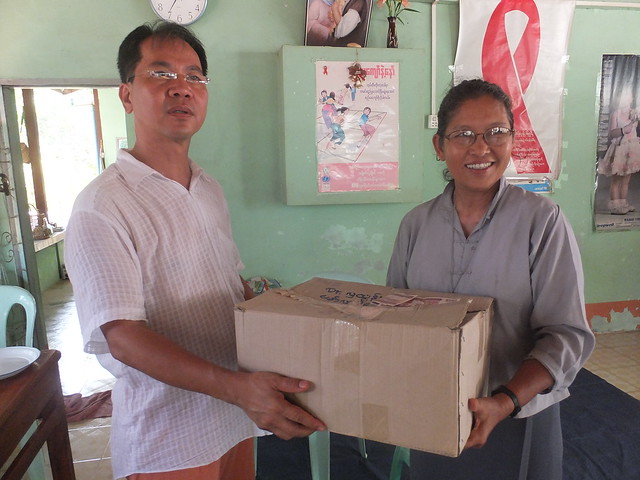 Doctor Hla Tun donates medication to Sister Martha at 'Mirror Image'.
Doctor Hla Tun donates medication to Sister Martha at 'Mirror Image'.
Finally, we detoured to the popular beach at Setse, where I was able to paddle in the Andaman Sea and enjoy fresh coconut milk with the Doctor and his Son. There were lots of people enjoying the beach but, this far from Yangon, traditional modesty prevails. A group of laughing young women running across the hot sand were dressed more for a Sunday School Outing than for the beach.
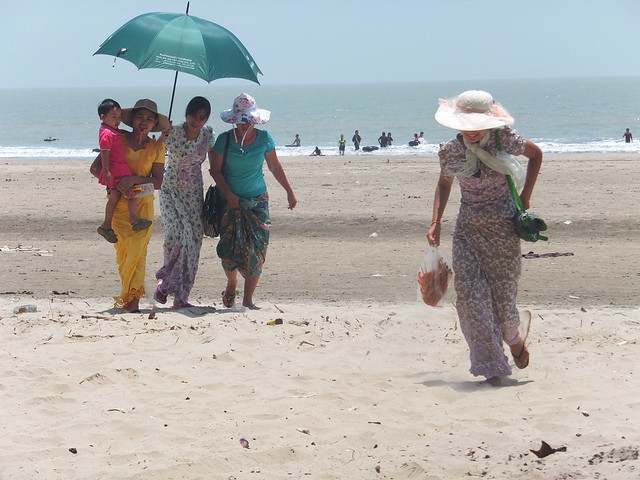 Setse Beach.
Setse Beach.
We made our way back north to Mawlamyine, pausing to buy fruit from a roadside stall. We visited two more DICs in the Mawlamyine area - Hlaing and 'Future Generation'. The population of Mawlamyine is around 300,000 and there are some decidedly poor areas.
At Hlaing, we were almost physically overwhelmed by around 400 youngsters (less than 300 had been expected). 'SKYNET' had a television cameraman and lady interviewer there and the Doctor recorded an improptu interview for them before we started the distribution. As before, there were some donations of financial assistance before the umbrellas and stationery were given out. The sheer numbers meant that the organisation did not always run smoothly but it all worked out, I think. Some rapid re-allocation had to be made of the stationery we had with us so that everybody received something on the day and the Doctor intended to send more items once he was back in Yangon.
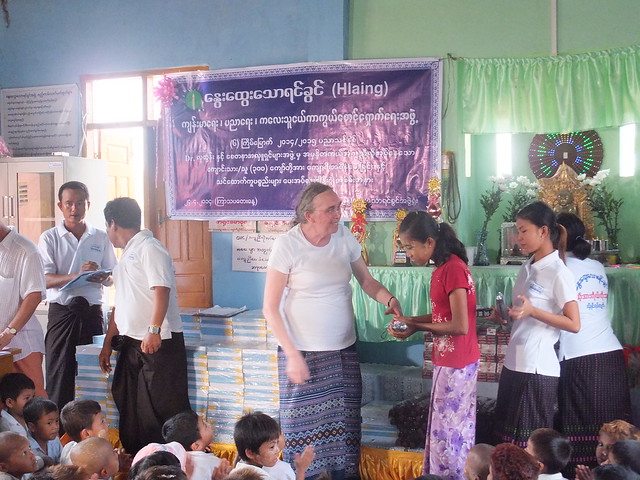 Distributions in progress at Hlaing.
Distributions in progress at Hlaing.
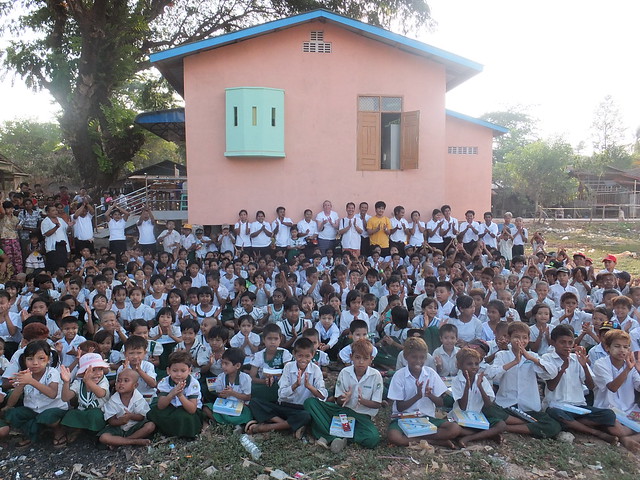 The 'Group Shot' at Hlaing.
The 'Group Shot' at Hlaing.
Our last distribution was at 'Future Generation' - a small DIC in a new building run by a charming lady. Both she and one of her assistants had computer science degrees. Once again, I was impressed by the commitment of all the volunteers who run these centres.
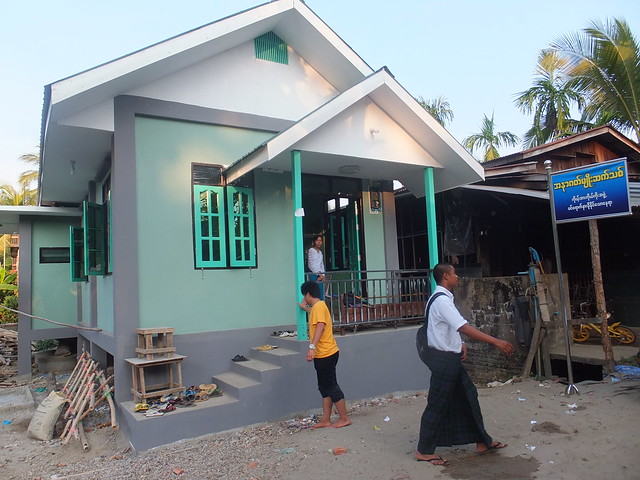 'Future Generation', Mawlamyine.
'Future Generation', Mawlamyine.
Our arrival was eagerly awaited by the young children who filled the D.I.C. and we soon completed the final distribution of our trip to Mon State.
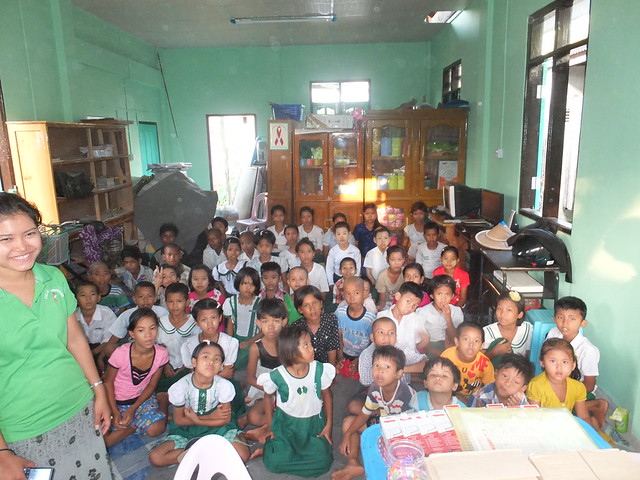 Young children eagerly awaiting the distribution at 'Future Generation'.
Young children eagerly awaiting the distribution at 'Future Generation'.
The children departed for the day and we chatted to the volunteers for a while before they, too, got ready to leave. By this time it was getting dark. We drove to the famous Strand at Mawlamyine which always takes on a holiday atmosphere at sunset. We strolled for a while amongst the happy crowds before driving to visit one of the famous hill-top temples. Finally, we drove to the P.T.T. Bus terminal in time to catch the 21:30 overnight bus to Yangon.
My Pictures
Thanbyuzayat area, Myanmar.
Khaikhami Yele Paya Shrine, Myanmar.
'Mirror Image' Orphanage.
Hlaing Drop In Centre, Mawlamyine.
'Future Generation' Drop In Centre, Mawlamyine.
Mawlamyine, Myanmar.
Mawlamyine - Yangon by Coach.
More
Next Post describing this trip.
[Revised 15-May-2014, 16-May-2014]
